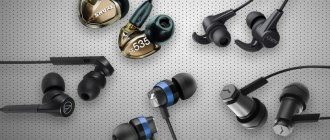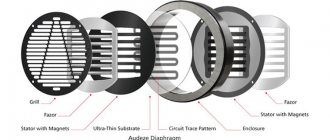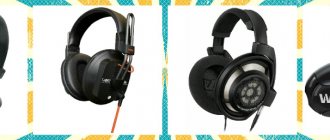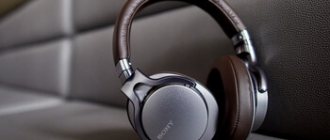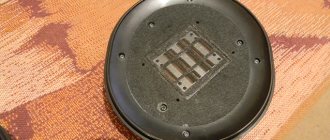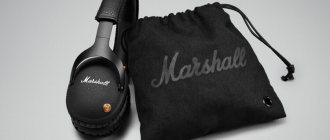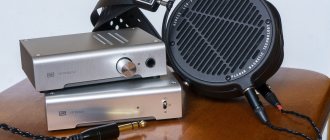Back in black
“I’ve seen these headphones somewhere before!” - that was the first thought that came to me when I picked up the LCD-X. Indeed, the only difference in appearance from the previously tested LCD-2 Classic is the shape of the cable entry. In LCD-X, the protruding part of the body with the connector is made in the form of a tide, orienting the connector tangentially to the circumference of the earcup - in a word, exactly as it is done in other modern models of the LCD series (in my opinion, this location is more convenient). Otherwise, we have the same aluminum cups, anodized black, and the same metal headband with perforated leather pad. Stylish, strict and brutal.
The rugged design of the LCD-X reminded me of the LCD-2 Classic
But the internal contents of the cups differ from the classic second model quite seriously. Ultra-thin Uniforce diaphragms are designed specifically for these headphones and (unlike license plate LCDs) have a low impedance of only 20 ohms. All to ensure that the headphones work adequately with low-power amplifiers, including those built into portable devices and studio equipment. The dual Fluxor magnetic system, complemented by Fazor waveguides, is borrowed from the older LCD-3 model.
Size, weight and form factor are classic
Like other models, the LCD-X can be ordered in two versions: with genuine leather or microsuede trim. The second option, in my opinion, is more suitable for long-term use. In both cases, the ear pads are large and fit as comfortably as possible. The tangible weight of the headphones is distributed as evenly as possible. If desired, you can even reduce it a little by replacing the metal headband with a carbon one, but even in this case, the LCD-X headphones are not an easy burden. Just like any other full-size planars, in which the sound quality and weight-dimensional characteristics are directly proportional.
Persons under investigation
Audeze LCD-XC
I have known this company for quite some time and my relationship with it is very uneven. Exactly the same as the sound from this company. I admit, for me it was never particularly smooth, particularly monitor-like, or even “planar” in the usual sense of the latter. And yet, making allowances for the good looks... Although it’s more that the last two models turned out to be not so bad, I decided to give the LCD-XC a chance. Still top. So they will show what they can do.
Mr. Speakers Ether C Flow Closed
Of course, planar sound itself is very ephemeral and conditional. In the sense that it is impossible to accurately determine the technology by ear. So, its features are also conditional and everyone means by this concept what they want. So, by this I will mean the rationale for another planar participating in the battle. I liked the 2x2 format, so the Audeze LCD-XC's teammate will be Mr. Speaker Ether Flow Closed . I had previously listened to both versions of Æon and found the closed ones to be more optimal. So it was the turn of the older model.
Fostex TH900 mk2
The dynamic camp will be represented by a couple of quite predictable, but no less interesting models. This is Fostex TH900 second revision. In my opinion, this is one of the best models of its form factor. If you need a slightly lighter emotional presentation.
Focal Stellia
And the four are completed by another masterpiece from the French Focal. I say this both as a spoiler and as a personal belief. If I had already listened to Elegia earlier, and it showed excellent results in conjunction with Flux Lab Iriy and AK Kann Kube, today Focal Stellia will be a contender for the laurels.
Made for a studio?
The sound of the LCD-X headphones undoubtedly has studio features. It is very collected, clear, with high resolution. However, this is not to say that the tuning is perfectly smooth. On the contrary, at mid frequencies there is a small but specific accent, making the sound more articulate and prominent. The top ones, to my ears, are few. They play somewhere in the distance, which is why about half of the test compositions turn out darker and more intimate than they should be.
The model is based on a low-impedance diaphragm designed specifically for working with studio equipment
The bass also seems to be moved away from the listener, but only slightly. There were no complaints about its quality - it is extremely smooth, focused, and, importantly, it does not require high power to control it (even amplifiers of portable devices can handle headphones quite well).
Wide perforated leather cushion distributes weight comfortably
The sound nature of the LCD-X reminded me of the LCD-2, but the Xs not only focus attention on details and make the mids more expressive - they provide more musical information. As a result, it is with LCD-X that we have a better chance of looking into the very essence of the music, understanding the structure of the composition, the character of the sound of the instruments, and the emotions that the performer put into it. So I looked in.
Design and ergonomics
This is where manufacturers are already trying their best.
Focal offer traditional technophile and glamorous designs with a touch of cocoa. The model stands out from other headphones by choosing creamy brown as the main color. Traditional attention to detail, spring-loaded cups, the softest ear pads and headband, correct clamping force - in general, headphones cannot be called anything other than a supercar in the world of audio.
Fostex and Mr. Speakers use approximately the same design, the differences are in the headband. Both are comfortable, but the latter are noticeably lighter. Yes, due to deliberate work aimed at this, but these are not empty words. Having more or less gotten used to the weight of the other headphones, each time I put on the Ethers I was involuntarily surprised by their discrepancy between size and weight. Fostex, at first glance, doesn’t really bother with this, although they also don’t weigh that much.
And the leader at the weighing is Audeze LCD-XC . Or rather an outsider. Yes, the bowls are the largest in diameter, but also the heaviest. Natural materials give their charm. The combination of leather, metal and wood cannot but please, but all this, gram for gram, gives the headphones a weight of 0.75 kg. Yes, I weighed it on purpose. And he specifically wrote the weight in kilograms. To make it more clear, as they say. Agree, this is not so little. Comfortable wrap-around ear pads, a comfortable headband and the right clamping force provide the LCD-XC with good weight distribution, but this does not make the headphones particularly light.
And in organoleptic terms, Focal is still the leader. The softest ear pads, comfortable headband, comfortable pressure. There is a sense of deliberate work not only on the sound and design, but also attention to how the chosen materials turn out tactilely. But to the credit of the other models, they are also quite convenient and comfortable to wear. And based on the sum of the parameters here, I would choose either Focal Stellia or Ether C Flow.
To the core
The headphones easily disassembled Ozzy Osbourne's hit with the cynical name “Suicide Solution” into its components without destroying the mood of the composition. It was even somehow surprising to hear that this sound mess could actually be quite legible and understandable, with clearly distinguishable instrument parts and clearly defined notes. To consolidate the experience, I included a more modern and cleanly played track “Fly High” by Ray Wilson and his Stiltskin team. And again, the headphones carefully “sorted out” the entire barrage of sounds. All the guitars were clearly audible individually, and the overall picture and mood were also conveyed well. And although some headphones of comparable price and class could convey the mood better, few can compete with the LCD-X in terms of detail and clarity of reproduction.
Screws facing outwards and black color in a circle - a sign of a working tool
The LCD-X demonstrated a successful balance between analysis, detail and expressiveness when it came to System Of A Down's Toxicity album. Both guitars and vocals played extremely clearly, but there was little top end, which is why the sound showed softness and even warmth. But perhaps this is what made the sound more alive and emotional. Joe Cocker sang about the capture of Manhattan energetically and convincingly, his voice only slightly lacking in lower overtones.
The design is very durable and solid: only metal and no plastic
Luciano Pavarotti's vocals were reproduced almost flawlessly, without harshness or discomfort in the upper notes. That feeling of freedom and flight, which is invariably present in the voice of the famous tenor, was felt to the fullest. And in the compositions from Alan Parsons’ album “I Robot” the same feeling of open and free sound was no longer there. The signature atmospheric and airy sound of the art-rock master turned out to be unexpectedly warm, cozy and intimate.
The metal headband is attached to a metal cup - everything is very secure
The composition “Revelation” from Marcus Miller’s album “Renaissance” sounded very interesting. The lead bass guitar is located in the foreground, and the rest of the instruments seem to be on the sides and even behind. This became especially noticeable in moments when the bass and electric guitar played the same melody. I'm used to hearing this thing in a slightly different, more uniform and solid presentation of instruments, although this version was definitely good. At the same time, the detail and rhythm are at their best: each instrument is distinct, they do not mix with each other, the rhythmic patterns do not get confused or stumble. This is a sure sign that the headphones do not have significant unevenness in the low/mid range. I didn't feel any lack of top end in this recording.
Mini XLR connector provides secure cable retention
The theme set by Marcus was successfully continued by Jheena Lodwick with a free jazz version of the famous standard “Close To You”. On this composition, the headphones again pleased with their excellent rhythm, clarity of the bass line and expressive relief vocals.
On Alice Merton's debut EP No Roots, the LCD-X showed excellent detail, perfectly controlled sound and a moderate, restrained transfer of emotional content. “Jealousy” was not as exciting as I heard it performed by the LCD-2 Classic, and the LCD-X were able to shine on the more dynamic “Hit the Ground Running.” Mainly due to good transmission of dynamics and higher detail. If we talk about direct comparison, the LCD-2 Classic sounded lighter and brighter in both cases, and the LCD-X sounded more solid and detailed.
Balanced connection is one of the ways to improve scene elaboration and improve sound quality in general
Glenn Gould's Goldberg Variations on Johann Sebastian Bach sounded great from the first note to the last. The piano was realistic and moderately bright, as when listening live. The performer's temperament and mood were conveyed well.
In general, the headphones turned out to be quite omnivorous. As with the LCD-2, either version lacked treble at times, and the LCD-X periodically emphasized certain instruments and parts in the midrange, thereby detracting from the rest of the playable range. The sound of the LCD-X as a whole turned out to be, first of all, extremely informative and at the same time quite musical.
Test conditions
And as a referee in pair with my old Audio-GD NFB29, I decided to add the mentioned Iriy. He is also not a timid person. And testing on several devices is always more revealing than testing on one. Therefore, iBasso DX220 on amp8 will act as a portable player. Not as crazy and unrestrained exhaust power as, say, Mad Max or Kann Kube. But the player is also not a timid one. And a noticeably more compact and quite portable device (and not like some!). So it will be even more revealing.
Of course, there is no question of fully testing stationary headphones from a portable player. It’s here rather in case of “what if you want to take these headphones into a portable device.” Yes, a surprising number of full-size fans want to listen to them from a portable device. Still, given the capabilities of the headphones, I can’t recommend this. This is true for LCD-XC. (Although, here’s how I’ll imagine their combination with Kann Cube - almost one and a half pounds of portable.)
Measurements
The measurement results generally differ little from other Audeze LCD series models. The key differences, as always, occur in the middle and right parts of the frequency response graph, with the left half actually linear. Namely, the left side of the graph accounts for most of the fundamental tones of instruments and the human voice.
The nature of the sound of mid frequencies determines the rise in frequency response, reaching a peak in the region of 700-800 Hz. A rise of a similar nature (but less pronounced in amplitude) at frequencies of 800-1000 Hz was observed in both LCD-2C and LCD-4. But the 1-3 kHz region of the LCD-X falls deeper than the above-mentioned models. And the LCD-X has very little in common with the donor model LCD-3.
For the sake of objectivity, I would like to note that if we had had headphones from other brands specializing in studio headphones at our stand, we would have gotten a much less linear result, at least on the left side of the graph up to 1 kHz.
The LCD-X distortion level changes stepwise across frequencies, a good value of 0.5% in the low-frequency region, almost ideal midrange with an average value of 0.2% and quite traditional fluctuations on the right side of the graph, ranging from a record low of 0.1% and up to a large, but still quite acceptable value of 1%.
Results
All headphones are good (of course, considering their price!), and I completely understand the adherents of each technology and each model. Those who like more drive will choose Fostex TH900 mk2 or Mr. Speaker Ether C Flow. For those who want maximum monitor sound - Audeze LCD-XC. Well, for those who want both drive and reference - Focal Stellia. If the question is about placing places according to quality and set of characteristics, regardless of handwriting, then my favorite of the competition is Stellia. I would put Fostex and Ether in second place, depending on personal preferences. And the LCD-XC closes the comparison. But, of course, for you, on your source and music, everything may be completely different.
Convenience
The headphones fit nicely, but after a while a feeling of increased pressure in the head is created - a slightly noticeable ringing appears in the ears. And then it dawned on me that I don’t really understand why these headphones are called open, because the tightness of the fit to the ears, the feeling of pressure, the materials of the ear pads are all from closed ones.
It would probably help me to replace the supplied ear pads with third-party velor ones, if there were any. My personal Beyerdynamic DT 990 Pro have similar ear pads. Fortunately, these “Odizi” have them easily replaced:
There's just one problem: I couldn't find any spare pairs in other stores. Hope they go on sale soon.
In general, the headphones turned out to be very comfortable - the lambskin leather ears do not sweat, they fit easily into the ear pads, and during active and vigorous playing of instruments they do not fall off, confidently remaining on the head.
I specifically say that I play with these headphones. Because music, from the point of view of its creators, is very demanding on sound. And, unfortunately, no modern wireless technologies can help here. First of all, I'm talking about delays: you pluck the string, and the sound is delayed. At the initial level of a musician, minimal delays are still tolerable, but for professionals this is crazy.
Secondly, sound quality and detail are important - you need to hear every movement of your fingers on the strings in order to improve your playing and find new, more accurate ways to produce sound.
List of albums that were used for the test
- Agusti Fernandez, Barry Guy, Ramon Lopez - Aurora
- Kristin Asbjornsen — Wayfaring Stranger A Spiritual Songbook
- Emerson, Lake & Palmer - Brain Salad Surgery
- King Crimson - Islands
- Cowboy BeBop — Original Soundtrack I
- Morphine - Cure For Pain
- Johnny Cash - American V
- Ayreon - The Human Equation
- Gogol Bordello - Trans-Continental Hustle
- Supertramp - Crime Of The Century
- Dropkick Murphys - The Meanest of Times
- Tord Gustavsen Ensemble — Restored, Returned
- Rolf Lislevand - Encuentro Sanz & Santa Cruz
- Giuliano Carmignola — Vivaldi: The Four Seasons
- Paul O'Dette - Kapsberger, G.: Lute Works
- Shirley Rumsey - Music Of The Spanish Renaissance
- Beady Belle - At Welding Bridge
- Randi Tytingvåg – Red
- Allan Taylor - Hotels & Dreamers
- Jim White - Drill a Hole in That Substrate and Tell Me What You See
- Doug MacLeod - Whose Truth, Whose Lies
- Otis Taylor - Hey Joe Opus Red Meat
- Anna Maria Jopek – Bosa
- The Tiger Lillies - The Brothel to the Cemetery
- Civil Defense - Why do you have dreams?
Audeze LCD—2
| Headphone type | Full size, open |
| Emitter type | Magneto-planar |
| Magnet placement | Branded double matrix (magnets are located on both sides of the diaphragm) |
| Phase correction | FAZOR |
| Magnet material | Neodymium |
| Aperture type | Ultra-thin |
| Emitter diameter | 106 mm |
| Maximum power input | 15 W |
| Sound pressure level | >130dB |
| Frequency range | 10Hz – 50kHz |
| Harmonic distortion factor | <1% over the entire frequency range |
| Impedance | 70 Ohm |
| Sensitivity | 101 dB/1 mW |
| Optimal amplifier power | >100mW |
Author of text and photo: Yuri Volobuev
Prepared based on materials from the portal “Soundex.ru”, August 2018
mag.soundex.ru This review was read 8,385 times
Marvels of Engineering
The most interesting feature of these headphones, in my opinion, is absolutely brilliant, also because technically it is extremely simple. LCD-1 are equipped with a “magic” Y-shaped cable with standard 3.5 mm jacks, connected to the left and right headphones in any order.
At the same time, the left and right headphones reproduce their channel. You can switch the cables the other way around and nothing will change: the left earphone will still have the left channel, and the right earphone will still have the right channel.
Magic? Magic? Secret technologies of NASA? Everything is much simpler: the connectors connected to the headphone cups are three-pole. And each of them transmits a signal from both the left and right channels. Which one gets to the emitter is determined by the wiring in the headphone cup socket. The solution is so simple that you immediately begin to wonder why it is not used everywhere?
And most importantly, this is a really useful option. Musicians are creative, passionate people, and when they need to listen to a new recording, they are not inclined to look at the inscriptions on the cable and compare them with the marks on the ear cups - they would rather connect and hear what happened there! A randomly connected cable is the only way to eliminate channel confusion.
Another simple, but technically important property of a cable is its length. For LCD-1 it is optimal - based on the scope of application - and is two meters. Not three meters, which give too much freedom and get underfoot, and not 1.25 m, which literally ties the user to the amplifier. Two meters is optimal for the studio, use with a computer, listening to a home hi-fi system, and is not a big problem for infrequent use with a smartphone or portable player somewhere on the road.


